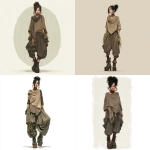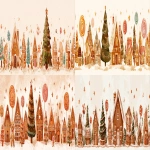Explore the Best AI Image Gallery

Beyond the Canvas: How Edge Computing Empowers Creative Innovation
The creative landscape is undergoing a seismic shift, driven by the convergence of technology and human ingenuity. At the forefront of this transformation stands edge computing, a paradigm that brings computation and data storage closer to the source of data generation. This decentralized approach unlocks unprecedented possibilities for artists, designers, and innovators, empowering them to create immersive experiences, collaborate seamlessly, and push the boundaries of artistic expression.
Edge Computing: A Catalyst for Creative Evolution
Traditionally, creative workflows relied on centralized servers, often resulting in latency issues, bandwidth constraints, and limitations in real-time collaboration. Edge computing dismantles these barriers by processing data at the device level, enabling instantaneous responses and fostering a more fluid creative process.
Redefining Creative Collaboration
Imagine a team of designers scattered across continents, seamlessly collaborating on a 3D model in real time, each contributing their expertise and visualizing changes instantly. Edge computing makes this a reality by facilitating low-latency communication and distributed data processing, fostering a truly collaborative creative environment.
Immersive Experiences: A New Dimension of Creativity
Edge computing empowers artists to create immersive experiences that blur the lines between the physical and digital realms. Augmented reality (AR) and virtual reality (VR) applications can leverage edge devices to process sensor data in real time, creating dynamic and responsive environments that engage users on a deeper level.
Democratizing Creativity: Accessible Tools for Everyone
Edge computings ability to process data locally opens up new possibilities for democratizing creativity. Artists and designers no longer require access to powerful central servers, enabling them to experiment with cutting-edge tools and techniques using readily available edge devices.
Applications in the Creative Industry
- Interactive Art Installations: Edge computing enables artists to create dynamic installations that respond to viewer input in real time, blurring the lines between observer and participant.
- Immersive Storytelling: VR and AR experiences powered by edge computing can transport audiences into captivating narratives, fostering deeper emotional connections with stories.
- Personalized Creative Tools: Edge devices can analyze user preferences and behaviors to provide personalized creative suggestions and tools, empowering individuals to explore their artistic potential.
- Real-Time Design Collaboration: Architects, designers, and engineers can collaborate seamlessly on projects using edge-enabled platforms, facilitating efficient and dynamic workflows.
Ethical Considerations
While edge computing offers immense creative potential, it also raises important ethical considerations:
- Data Privacy: Processing sensitive user data on edge devices necessitates robust security measures to protect individual privacy.
- Bias and Fairness: AI algorithms used in creative applications can perpetuate existing biases if not carefully trained and monitored. Its crucial to ensure equitable outcomes and avoid reinforcing societal inequalities.
- Accessibility and Inclusion: Access to edge computing technology should be equitable, ensuring that all individuals have the opportunity to participate in the creative economy.
Future Trends
The intersection of edge computing and creativity is poised for continued evolution. Future trends include:
- Enhanced Immersive Experiences: Edge computing will drive increasingly realistic and interactive VR and AR experiences, blurring the lines between reality and virtuality.
- Personalized Creative Assistants: AI-powered creative assistants will leverage edge computing to understand user preferences and provide personalized guidance, inspiration, and feedback.
- Democratization of 3D Creation: Edge devices will empower individuals to create and manipulate 3D models with ease, fostering a more inclusive and accessible 3D design ecosystem.
Conclusion
Edge computing is revolutionizing the creative landscape, empowering artists, designers, and innovators to push boundaries and explore new frontiers. By enabling real-time collaboration, immersive experiences, and on-demand processing power, edge computing is democratizing creativity, fostering a more inclusive and dynamic future for the arts.







](https://images.ai-img.art/thumbnails/150/a386b7328d9a450c8a0cafbdad5815eeb35b0177d0e8fa85f97cbaa5fee75954.webp)














](https://images.ai-img.art/thumbnails/150/ec0cb0bee85af7229e33a02acb89441c1cf702d21b383b244148fbc0d36b85dc.webp)









](https://images.ai-img.art/thumbnails/150/21e921e68d4754d45ff17adc76eeaabe152c41a580321a7ec899dcfdf935afca.webp)







](https://images.ai-img.art/thumbnails/150/42d2d357bc68a8f707abfc29c35e7c9b5388d6559e4e2b94ba648cf0cf734bb1.webp)








